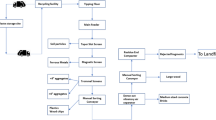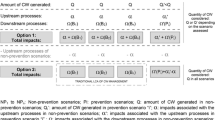Abstract
Currently, the majority of the construction waste (CW) has been collected without classification and simply disposed in China. To quantify the environmental impacts and provide reasonable policy recommendations, this paper conducted an assessment for the life cycle carbon emissions (CEs) for CW based on a streamlined life cycle assessment method. Three typical CW management approaches in Shenzhen City were selected to perform the case study and comparative analysis. The results show that scenario I with low recycling rate generates the largest CEs amount by 542.56 kg for 1 ton CW, followed by scenarios II and scenario III that generate 538.61 and 483.85 kg, respectively. In addition, the results show the material embody impact is the largest contributor to CEs for CW examined, accounting for 78 % of the total amount in the overall life cycle. Analysis results also show that wood, steel and concrete wastes are the top three contributors within nine materials, with proportions of 25, 23 and 13 %, respectively. Therefore, the most effective way to decrease the CEs of CW is minimizing the generation of CW, since the CEs of the majority of waste are not sensitive to alteration of treatment methods or recycling rate.






Similar content being viewed by others
References
Lu W, Yuan H, Li J et al (2011) An empirical investigation of construction and demolition waste generation rates in Shenzhen city, South China. Waste Manag 31(4):680–687
Wang JY, Kang XP, Wing-Yan Tam V (2008) An investigation of construction wastes: an empirical study in Shenzhen. J Eng Design Technol 6(3):227–236
National Development and Reform Commission (NDRC) (2015) China Resources Comprehensive Utilization annual report (2014). http://www.sdpc.gov.cn/xwzx/xwfb/201410/W020141009609573303019.pdf
Li JR, Ding ZK, Mi XM, Wang JY (2013) A model for estimating construction waste generation index for building project in China. Resour Conserv Recycl 74(5):20–26
Erlandsson M, Levin P (2005) Environmental assessment of rebuilding and possible performance improvements effect on a national scale. Build Environ 40(11):1459–1471
Yeheyis M, Hewage K, Alam MS et al (2013) An overview of construction and demolition waste management in Canada: a lifecycle analysis approach to sustainability. Clean Technol Environ Policy 15(1):81–91
Usapein P, Chavalparit O (2015) Evaluating the performance of 3R options to reduce landfill wastes using the 3R indicator (3RI): case study of polyethylene factories in Thailand. J Mater Cycles Waste Manage 17(2):303–311
Esin T, Cosgun N (2007) A study conducted to reduce construction waste generation in Turkey. Build Environ 42(4):1667–1674
Peng CL, Scorpio DE, Kibert CJ (1997) Strategies for successful construction and demolition waste recycling operations. Constr Manag Econ 15(1):49–58
Mercante IT, Bovea MD, Ibáñez-Forés V et al (2012) Life cycle assessment of construction and demolition waste management systems: a Spanish case study. Int J Life Cycle Assess 17(2):232–241
Blengini GA (2009) Life cycle of buildings, demolition and recycling potential: a case study in Turin, Italy. Build Environ 44(2):319–330
Ortiz O, Pasqualino JC, Castells F (2010) Environmental performance of construction waste: comparing three scenarios from a case study in Catalonia, Spain. Waste Manag 30(4):646–654
Blengini GA, Di Carlo T (2010) The changing role of life cycle phases, subsystems and materials in the LCA of low energy buildings. Energy Build 42(6):869–880
Kucukvar M, Egilmez G, Tatari O (2014) Evaluating environmental impacts of alternative construction waste management approaches using supply-chain-linked life-cycle analysis. Waste Manage Res 32(6):500–508
Bala A, Raugei M, Benveniste G et al (2010) Simplified tools for global warming potential evaluation: when ‘good enough’ is best. Int J Life Cycle Assess 15(5):489–498
Olivetti E, Patanavanich S, Kirchain R (2013) Exploring the viability of probabilistic under-specification to streamline life cycle assessment. Environ Sci Technol 47(10):5208–5216
Olivetti EA, Duan H, Kirchain R (2012) Method development for carbon footprint assessment as applied to motor and lighting products: summary report for NEMA, 2012. Massachusetts Institute of Technology, Cambridge
Olivetti EA, Duan H, Kirchain R (2013) Guidance document for product attribute to impact algorithm methodology: summary report for NEMA, 2013. Massachusetts Institute of Technology, Cambridge
Kofoworola OF, Gheewala SH (2009) Estimation of construction waste generation and management in Thailand. Waste Manag 29(2):731–738
Coronado M, Dosal E, Coz A et al (2011) Estimation of construction and demolition waste (C&DW) generation and multicriteria analysis of C&DW management alternatives: a case study in Spain. Waste Biomass Valoriz 2(2):209–225
Acknowledgments
This study was supported by the Australian Research Council Project “Re-considering Sustainable Building and Design: A Cultural Change Approach” (Project ID: LP110100156) and Research Center of Urban Resource Recycling Technology of Graduate School at Shenzhen, Tsinghua University and Shenzhen Green Eco-Manufacturer High-Tech, Co. Ltd. (URRT2014002) for funding and support. In addition, the authors would like to acknowledge Mr. Kevin Zhang and the three anonymous reviewers for valuable comments.
Author information
Authors and Affiliations
Corresponding authors
Rights and permissions
About this article
Cite this article
Wu, H., Duan, H., Wang, J. et al. Quantification of carbon emission of construction waste by using streamlined LCA: a case study of Shenzhen, China. J Mater Cycles Waste Manag 17, 637–645 (2015). https://doi.org/10.1007/s10163-015-0404-9
Received:
Accepted:
Published:
Issue Date:
DOI: https://doi.org/10.1007/s10163-015-0404-9




